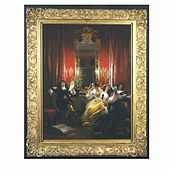Charles Robert Leslie
| Charles R. Leslie | |
|---|---|
 Self-portrait of Charles Robert Leslie, 1814 | |
| Born |
19 October 1794 London |
| Died | 5 May 1859 (aged 64) |
| Nationality | British |
| Field | Genre Oil Painting |
Charles Robert Leslie RA (19 October 1794 – 5 May 1859) was an English genre painter.
Biography
Born in London, his parents were Americans. When he was five years of age he returned with them to their native country. They settled in Philadelphia, where their son was educated and afterwards became apprenticed to a bookseller. He was, however, mainly interested in painting and drama, and when George Frederick Cooke visited the city he executed a portrait of the actor from recollection of him on the stage, which was considered a work of such promise that a fund was raised to enable the young artist to study in Europe.[1]
He left for London in 1811, bearing introductions which procured for him the friendship of West, Beechey, Allston, Coleridge and Washington Irving, being admitted as a student of the Royal Academy, where he carried off two silver medals. At first, influenced by West and Fuseli, he essayed high art, and his earliest important subject depicted Saul and the Witch of Endor; but he soon discovered his true aptitude and became a painter of cabinet-pictures, dealing, not like those of David Wilkie, with the contemporary life that surrounded him, but with scenes from the great masters of fiction, from Shakespeare and Cervantes, Addison and Molière, Swift, Sterne, Fielding and Smollett. [1]
In 1821, Leslie was elected A.R.A., and five years later full academician. In 1827 he was elected into the National Academy of Design as an Honorary Academician. In 1833, he left for America to become teacher of drawing in the military academy at West Point, but the post proved an irksome one, and in some six months he returned to England. He died 5 May 1859.[1]
Leslie was the brother of American author Eliza Leslie and United States Army soldier Thomas Jefferson Leslie. His youngest son, George Dunlop Leslie RA (1835–1921) was also an artist of note and his middle son Bradford Leslie was a noted bridge builder.[2]
Works

Of individual paintings we may specify Sir Roger de Coverley going to Church (1819); May-day in the Time of Queen Elizabeth (1821); Sancho Panza and the Duchess (1824); Uncle Toby and the Widow Wadman (1831); Le Malade Imaginaire, act iii. sc. 6 (1843); and the Duke's Chaplain Enraged leaving the Table, from Don Quixote (1849). Many of his more important subjects exist in varying replicas.
He possessed a sympathetic imagination, which enabled him to enter freely into the spirit of the author whom he illustrated, a delicate perception for female beauty, an unfailing eye for character and its outward manifestation in face and figure, and a genial and sunny sense of humour, guided by an instinctive refinement which prevented it from overstepping the bounds of good taste.
In addition to his skill as an artist, Leslie was a ready and pleasant writer. His Life of his friend Constable, the landscape painter, appeared in 1843 is regarded as one of the classics of artistic biography [3] , also writing his Handbook for Young Painters, a volume embodying the substance of his lectures as professor of painting to the Royal Academy, in 1855. In 1860, Tom Taylor edited his Autobiography and Letters, which contain interesting reminiscences of his distinguished friends and contemporaries. Leslie's letters paint the man as affectionate, social, candid, modest and eager for instruction and improvement, always seeking the society of the best and most eminent of persons to whom he could gain access without intrusion or forwardness.[4] Taylor also finished Leslie's Life and Times of Sir Joshua Reynolds, which was published in 1865.[2]
Notes
Writings
- Memoirs of the Life of John Constable ed C.R.Leslie 1843, Chapman & Hall, London 1896
- Life and Times of Sir Joshua Reynolds, with Notices of Some of his Contemporaries ed Tom Taylor, John Murray, London 1865
- Handbook for Young Painters ( with illustrations),Johyn Murray, London 1855
- Autobiographical Recollections of C. R. Leslie with Selections from his correspondence Ed. Tom Taylor, Ticknor & Fields, Boston 1860
References
 This article incorporates text from a publication now in the public domain: Chisholm, Hugh, ed. (1911). "Leslie, Charles Robert". Encyclopædia Britannica (11th ed.). Cambridge University Press
This article incorporates text from a publication now in the public domain: Chisholm, Hugh, ed. (1911). "Leslie, Charles Robert". Encyclopædia Britannica (11th ed.). Cambridge University Press This article incorporates text from a publication now in the public domain: Wilson, James Grant; Fiske, John, eds. (1900). "Leslie, Eliza". Appletons' Cyclopædia of American Biography. New York: D. Appleton
This article incorporates text from a publication now in the public domain: Wilson, James Grant; Fiske, John, eds. (1900). "Leslie, Eliza". Appletons' Cyclopædia of American Biography. New York: D. Appleton
External links
| Wikiquote has a collection of quotations related to: Charles Robert Leslie |
| Wikimedia Commons has media related to Charles Robert Leslie. |
- King, Charles Robert; ed. with prefatory essay & selected correspondence by Tom Taylor (1860). Autobiographical Recollections. Boston: Ticknor & Fields. At Google Books; at Internet Archive.
-
 "Leslie, Charles Robert". New International Encyclopedia. 1905.
"Leslie, Charles Robert". New International Encyclopedia. 1905.
|